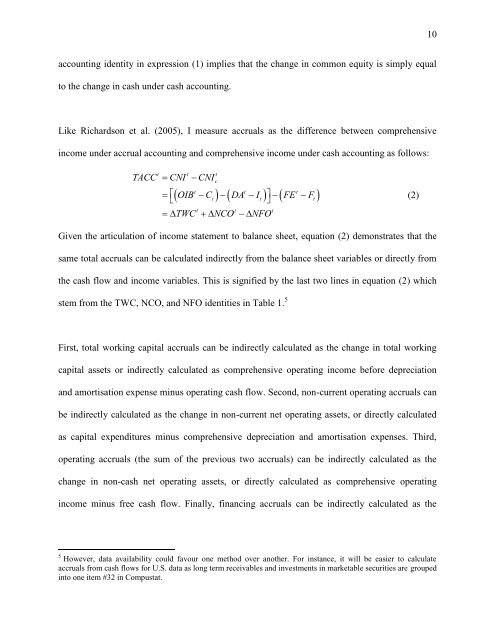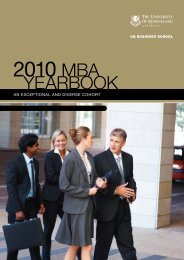Modelling the accruals process and assessing unexpected accruals*
Modelling the accruals process and assessing unexpected accruals*
Modelling the accruals process and assessing unexpected accruals*
You also want an ePaper? Increase the reach of your titles
YUMPU automatically turns print PDFs into web optimized ePapers that Google loves.
accounting identity in expression (1) implies that <strong>the</strong> change in common equity is simply equal<br />
to <strong>the</strong> change in cash under cash accounting.<br />
Like Richardson et al. (2005), I measure <strong>accruals</strong> as <strong>the</strong> difference between comprehensive<br />
income under accrual accounting <strong>and</strong> comprehensive income under cash accounting as follows:<br />
TACC CNICNI t t t<br />
c<br />
t t t<br />
OIB Ct DA It FE Ft<br />
<br />
<br />
<br />
<br />
TWC NCO NFO<br />
t t t<br />
Given <strong>the</strong> articulation of income statement to balance sheet, equation (2) demonstrates that <strong>the</strong><br />
same total <strong>accruals</strong> can be calculated indirectly from <strong>the</strong> balance sheet variables or directly from<br />
<strong>the</strong> cash flow <strong>and</strong> income variables. This is signified by <strong>the</strong> last two lines in equation (2) which<br />
stem from <strong>the</strong> TWC, NCO, <strong>and</strong> NFO identities in Table 1. 5<br />
First, total working capital <strong>accruals</strong> can be indirectly calculated as <strong>the</strong> change in total working<br />
capital assets or indirectly calculated as comprehensive operating income before depreciation<br />
<strong>and</strong> amortisation expense minus operating cash flow. Second, non-current operating <strong>accruals</strong> can<br />
be indirectly calculated as <strong>the</strong> change in non-current net operating assets, or directly calculated<br />
as capital expenditures minus comprehensive depreciation <strong>and</strong> amortisation expenses. Third,<br />
operating <strong>accruals</strong> (<strong>the</strong> sum of <strong>the</strong> previous two <strong>accruals</strong>) can be indirectly calculated as <strong>the</strong><br />
change in non-cash net operating assets, or directly calculated as comprehensive operating<br />
income minus free cash flow. Finally, financing <strong>accruals</strong> can be indirectly calculated as <strong>the</strong><br />
5 However, data availability could favour one method over ano<strong>the</strong>r. For instance, it will be easier to calculate<br />
<strong>accruals</strong> from cash flows for U.S. data as long term receivables <strong>and</strong> investments in marketable securities are grouped<br />
into one item #32 in Compustat.<br />
(2)<br />
10



